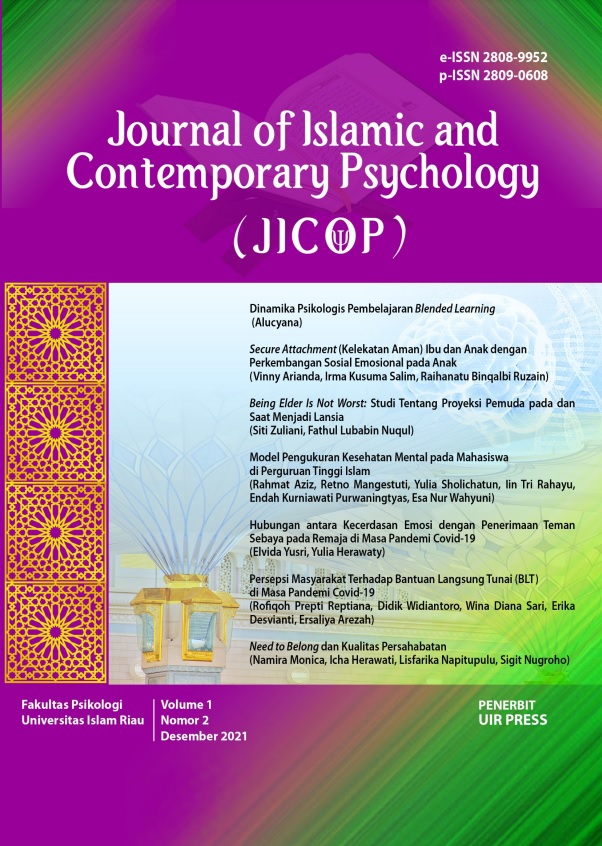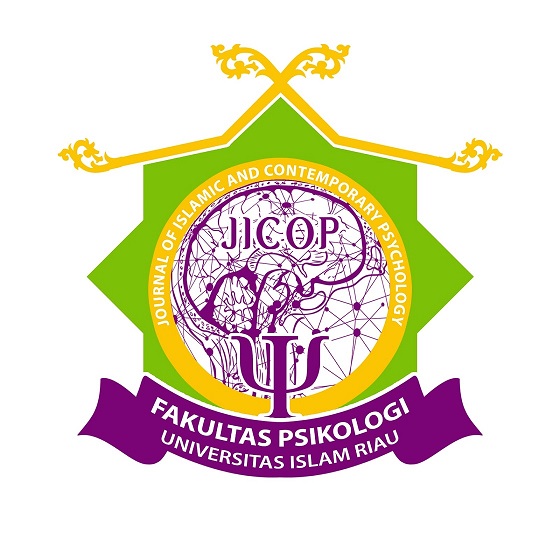Model Pengukuran Kesehatan Mental pada Mahasiswa di Perguruan Tinggi Islam
DOI:
https://doi.org/10.25299/jicop.v1i2.8251Keywords:
measurement, mental health, profiling, psychological distress, psychological wellbeingAbstract
The view that mental health can only be understood with a single approach can explain the existing phenomena. This paper aims to provide an alternative measurement model in conducting studies on student mental health. Data were obtained from 840 students at four state Islamic universities in East Java. Data was collected through the mental health scale. The percentage technique was used to examine the level and profile of mental health, while the variance analysis technique was used to investigate the differences between men and women. The analysis results show that the subjects have a high level of mental health and have a minimum mental illness profile. There was no evidence of a difference between men and women in terms of mental health. The results of this study have implications for the use of mental health measuring tools to be used as an alternative in measuring mental health.
Downloads
References
Asmika, A., Harijanto, H., & Handayani, N. (2008). Prevalensi depresi dan gambaran stressor psikolososial pada remaja sekolah menengah umum di wilayah kotamadya Malang. Jurnal Kedokteran Brawijaya, 24(1), 15–21. https://doi.org/10.21776/ub.jkb.2008.024.01.2
Aziz, R. (2015). Aplikasi model rasch dalam pengujian alat ukur kesehatan mental di tempat kerja. Psikoislamika, 12(1), 1–11. https://doi.org/10.18860/psi.v12i2.6402
Aziz, R., Wahyuni, E. N., & Wargadinata, W. (2017). Kontribusi Bersyukur dan Memaafkan dalam Mengembangkan Kesehatan Mental di Tempat Kerja. Insan: Jurnal Psikologi dan Kesehatan Mental, 2(1), 33–34. https://doi.org/10.20473/jpkm.V2I12017
Aziz, R., & Zamroni. (2020). Analisis faktor konfirmatori terhadap alat ukur kesehatan mental berdasarkan teori dual model. Psikoislamika : Jurnal Psikologi Dan Psikologi Islam, 16(2), 1–7. https://doi.org/10.18860/psi.v16i2.8199
Bariola, E., Lyons, A., & Lucke, J. (2017). Flourishing among sexual minority individuals: Application of the dual continuum model of mental health in a sample of lesbians and gay men. Psychology of Sexual Orientation and …. https://psycnet.apa.org/journals/sgd/4/1/43/
Bono, G. (2020). Stress and wellbeing in urban college students in the u.S. during the covid-19 pandemic: Can grit and gratitude help? International Journal of Wellbeing, 10(3), 39–57. https://doi.org/10.5502/ijw.v10i3.1331
Bruffaerts, R. (2018). Mental health problems in college freshmen: Prevalence and academic functioning. Journal of Affective Disorders, 225, 97–103. https://doi.org/10.1016/j.jad.2017.07.044
Chow, P. I. (2017). Using mobile sensing to test clinical models of depression, social anxiety, state affect, and social isolation among college students. Journal of Medical Internet Research, 19(3). https://doi.org/10.2196/jmir.6820
Clark, K. (2021). Investigating achievement and mental health through the dual- factor model. Dissertation Abstracts International: Section B: The Sciences and Engineering, 82(4-B).
Coles, M. (2016). Adolescent Mental Health Literacy: Young People’s Knowledge of Depression and Social Anxiety Disorder. Journal of Adolescent Health, 58(1), 57–62. https://doi.org/10.1016/j.jadohealth.2015.09.017
Corey L M, K. (2005). Mental Illness and/or Mental Health? Investigating Axioms of the Complete State Model of Health. Journal of Consulting and Clinical Psychology, 73(3), 539–548. https://doi.org/10.1037/0022-006X.73.3.539
Cowie, H., Boardman, C., Dawkins, J., & Jennifer, D. (2004). Emotional Health and Well-Being: A Practical Guide for Schools. SAGE Publications.
Deliviana, E., Maria Helena Erni, Putri Melina Hilery, & Novi Melly Naomi. (2021). Pengelolaan Kesehatan Mental Mahasiswa Bagi Optimalisasi Pembelajaran Online di Masa Pandemi Covid-19. Jurnal Selaras : Kajian Bimbingan Dan Konseling Serta Psikologi Pendidikan, 3(2). https://doi.org/10.33541/jsvol2iss1pp1
Deliviana, Erni, M. H., Hilery, P. M., & ... (2020). Pengelolaan kesehatan mental mahasiswa bagi optimalisasi pembelajaran online di masa pandemi covid-19. Jurnal Selaras: Kajian …. http://ejournal.uki.ac.id/index.php/sel/article/view/2700
Galsky, A. P. (2019). Validation of the Dual-Factor Model of Mental Health in College Students: An Investigation of Group Characteristics. digitalcommons.lsu.edu. https://digitalcommons.lsu.edu/gradschool_dissertations/5058/
Grych, J., Taylor, E., Banyard, V., & ... (2020). Applying the dual factor model of mental health to understanding protective factors in adolescence. American Journal of …. https://psycnet.apa.org/record/2020-15348-001
Iasiello, M., & Agteren, J. Van. (2020). Mental health and/or mental illness: A scoping review of the evidence and implications of the dual-continua model of mental health. Evidence Base: A Journal of Evidence …. https://doi.org/10.3316/informit.261420605378998
Keyes, C. L. M. (2013). Mental Well-Being: International Contributions to the Study of Positive Mental Health. Springer Dordrecht Heidelberg. https://doi.org/10.1007/978-94-007-5195-8
Li, X. (2015). Mild Depression Detection of College Students: an EEG-Based Solution with Free Viewing Tasks. Journal of Medical Systems, 39(12). https://doi.org/10.1007/s10916-015-0345-9
Mangestuti, R., Sholichatun, Y., Aziz, R., & Wahyuni, E. N. (2020). Urgency of resilience and optimism in improving students’ mental health. Jurnal Kajian Bimbingan Dan Konseling, 5(4), 154–161. https://doi.org/10.17977/um001v5i42020p154
McPherson, M. (2015). Library anxiety among university students: A survey. IFLA Journal, 41(4), 317–325. https://doi.org/10.1177/0340035215603993
Newcomb, M. E., Hill, R., Buehler, K., Ryan, D. T., & ... (2020). High burden of mental health problems, substance use, violence, and related psychosocial factors in transgender, non-binary, and gender diverse youth and young …. Archives of Sexual …. https://doi.org/10.1007/s10508-019-01533-9
Ngapiyem, R. (2020). … Gangguan Mental Emosional: Depresi, Ansietas, Stres Menuju Sehat Jiwa Pada Mahasiswa Keperawatan Semester I Di Salah Satu Sekolah Tinggi Ilmu Kesehatan …. Jurnal Kesehatan. http://repo.stikesbethesda.ac.id/509/
Pretsch, J., Flunger, B., & Schmitt, M. (2012). Resilience predicts well-being in teachers, but not in non-teaching employees. Social Psychology of Education : An International Journal; Dordrecht, 15(3), 321–336. https://doi.org/http://dx.doi.org/10.1007/s11218-012-9180-8
Qayoom, S., & Husain, A. (2016). Happiness and well-being. Indian Journal of Health and Wellbeing, 7(4), 461–464. http://search.proquest.com/docview/1792354699/abstract/D5BE2EDF42014A3BPQ/7
Rice, S., Oliffe, J., Seidler, Z., Borschmann, R., & ... (2021). Gender norms and the mental health of boys and young men. In … Lancet Public Health. thelancet.com. https://www.thelancet.com/journals/lanpub/article/PIIS2468-2667(21)00138-9/fulltext
Selkie, E. M. (2015). Cyberbullying, depression, and problem alcohol use in female college students: A multisite study. Cyberpsychology, Behavior, and Social Networking, 18(2), 79–86. https://doi.org/10.1089/cyber.2014.0371
Sneath, J. Z., Lacey, R., & Kennett-hensel, P. A. (2009). Coping with a natural disaster: Losses, emotions, and impulsive and compulsive buying. Marketing Letters, 20(1), 45–60. https://doi.org/http://dx.doi.org/10.1007/s11002-008-9049-y
Suldo, S. M., Thalji-Raitano, A., Kiefer, S. M., & Ferron, J. M. (2016). Conceptualizing High School Students’ Mental Health Through a Dual-Factor Model. School Psychology Review, 45(4), 434–457. https://doi.org/10.17105/SPR45-4.434-457
Tengland, P.-A. (2001). Psychoanalysis, Humanistic Psychology, and Positive Mental Health. In Mental Health (pp. 35–45). Springer, Dordrecht. https://link.springer.com/chapter/10.1007/978-94-017-2237-7_3
Ulita, S., Pongtambing, Anshari, D., Sopamena, Y., Sri, A. O., & Fitriani, Y. (2020). Konsistensi internal dan validasi kriteria pada alat ukur Kesehatan mental mahasiswa Universitas Hasanuddin. Gadjah Mada Journal of Psychology (GamaJoP), 6(2), 210–220. https://doi.org/10.22146/gamajop.55702
Veit, C. T., & Ware, J. E. (1983). The Structure of Psychological Distress and Well-Being in General Populations. Journal of Consulting and Clinical Psychology, 51(5), 730–742.
Wang, Z. H. (2020). Prevalence of anxiety and depression symptom, and the demands for psychological knowledge and interventions in college students during COVID-19 epidemic: A large cross-sectional study. Journal of Affective Disorders, 275, 188–193. https://doi.org/10.1016/j.jad.2020.06.034
Wani, I. A., & Singh, B. (2019). Effect of Islamic psycho-spiritual therapy in managing craving, withdrawal symptoms, and mental health problems among cannabis users. Mental Health, Religion and Culture, 22(7). https://doi.org/10.1080/13674676.2019.1581755
Westerhof, G. J., & Keyes, C. L. M. (2010). Mental Illness and Mental Health: The Two Continua Model Across the Lifespan. Journal of Adult Development, 17(2), 110–119. https://doi.org/10.1007/s10804-009-9082-y
Zamarro, G., & Prados, M. J. (2021). Gender differences in couples’ division of childcare, work and mental health during COVID-19. In Review of Economics of the Household. Springer. https://doi.org/10.1007/s11150-020-09534-7
Downloads
Published
How to Cite
Issue
Section
License
This work is licensed under a Creative Commons Attribution - ShareAlike 4.0 International License (CC BY-SA)
This is an open-access article distributed under the terms of the Creative Commons Attribution-ShareAlike 4.0 International License which permits unrestricted use, distribution, and reproduction in any medium. Copyrights of all materials published in Journal of Islamic and Contemporary Psychology (JICOP) are freely available without charge to users or / institution. Users are allowed to read, download, copy, distribute, search, or link to full-text articles in this journal without asking by giving appropriate credit, provide a link to the license, and indicate if changes were made. All of the remix, transform, or build upon the material must distribute the contributions under the same license as the original.








